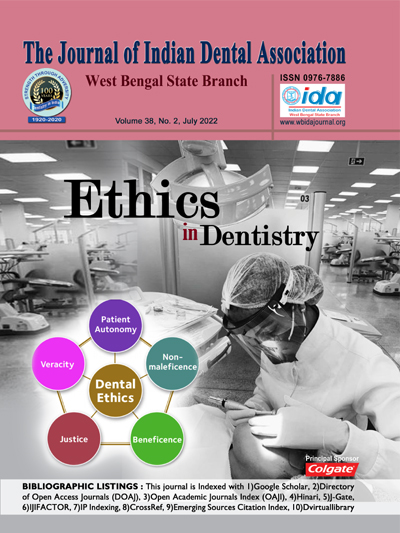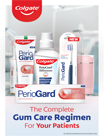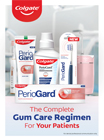Upcoming Events
1. Article Title.
2. Author Details.
3. Abstract.
4. Keywords.
5. Corresponding Author details.
July 2022
Volume : 38
No.: 2

Dr. Topi Nyodu,Dr. Raju Biswas,Dr. Soumen Pal,Dr. Santanu Mukhopadhyay,Dr. Somen Roy Chowdhury,Dr. Subir Sarkar,Dr. Nanmaran P N
Abstract: Pediatric laser dentistry is a promising field in minimally invasive dentistry, which enables the provision of better care for children and adolescents. Laser technology in pediatric dentistry has led to a massive expansion of different treatment possibilities for children as it has begun to be more popular based on the nature of pediatric dentistry which requires the need to deal with children from birth through adolescence along with parent's compliance. Prior to the application of the laser beam, careful selection of patients, and special attention to the reliable scientific literature regarding the safety, efficacy, and effectiveness of the technology are desired. Laser has opened new horizons in the treatment of both soft and hard tissue procedures because of their numerous benefits in soft tissue surgeries, reducing or completely eliminating the need for local anesthesia, providing a bloodless field during cutting, and eventless healing period due to the bactericidal and bio-stimulant effects of laser.
Abstract: Lipomas are benign mesenchymal tumors composed of mature adipocytes. Though they are abundant in head and neck region but intraoral lipomas are relatively uncommon. A case of intraoral lipoma occurring in right cheekin a 50-year-old male is reported along with discomfort and disfigurement of facial aesthetic. Wide surgical excision was performed and two-year follow up showed excellent healing without any recurrence.
Dr. Kasturi Mukherjee,Dr. Amit Shaw,Dr. Prakash Banerjee,Dr. Moumita Nayek
Abstract: Inpatients with severe dentofacial deformity beyond the scope of growth modification or orthodontic camouflage, the only possible solution left is surgery to reposition the jaws or dentoalveolar segments to their proper relationship. The correction of skeletal Class III malocclusion with severe mandibularprognathism in an adult individual is one such situation that requires combination of surgical and Orthodontic therapy. The case report of an adult individual with Class III malocclusion, having mandibular excess in sagittal and vertical plane and treated with orthodontics, bilateral sagittal split osteotomy for the correction of skeletal, dental and soft tissue discrepancies is herewith presented. The surgical-orthodontic combination therapy has resulted in near-normal skeletal, dental and soft tissue relationship, with marked improvement in the facial esthetics which in turn, has helped the patient to improve the self-confidence level.
Dr. Tanya Bansal,Dr. H.D. Adhikari,Dr. Abhijit Niyogi,Dr. Parthasarathi Mondal,Dr. Kurchi Mondal
Abstract: It is now understood that the type of diseased status ofcariously exposed pulp found in multirooted tooth may vary from one root canal to the other. In contrast to conventional endodontic therapy, this new conceptallows for different treatment options such as Vital Pulp Therapy (VPT) for the pulp in non infected root canal/s and Regenerative Endodontic Therapy (RET) or Non-Surgical Endodontic Therapy (NSET) in other root/s with bacterial contamination or pulpal necrosis. Presence of pulp tissue in the root canal helps to maintain proprioception, hydration of tooth, defense mechanism and thus, reducingthe propensity to tooth fracture. This case report illustrates the treatment of a mature mandibular first molar with Symptomatic Irreversible Pulpitis and Apical Periodontitis. Mesial root was treated with VPT and in distal root canals due to time constraints, single sitting NSET was performed instead of RET. A follow up of 12 months was done. The tooth is now asymptomatic, AP has healed, positive response to pulp sensibility test and subserving the normal function.
Dr. Tapas Paul,Dr. H.D. Adhikari,Dr. Abhijit Niyogi,Dr. Parthasarathi Mondal,Dr. Amrita Ghosh
Abstract: Periapical surgery aims to remove periapical pathology followed by achieving complete wound healing by regeneration of the bone and periodontal tissue. Regeneration of periapical bone defect is a challenge especially in case of large or through and through lesion, because of the time taken for bone regeneration and quick ingression of connective tissue within the defects. That is why it is advocated to use graft materials in place of the defect. The present case report focuses about healing of a large periapical lesion in relation to #21, #22 through combination use of- osteoconductive Hydroxyapatitecrystal (HA) with osteoinductive platelet rich fibrin (PRF) as graft materials after periapical surgery which was evaluated through CBCT. The patient was evaluated clinically and radiographically on 3rd, 6th and 12th month after surgery. He was asymptomatic and CBCT scans revealed remarkable reduction of area of bone defect (95.31 %) and increase in gain of bone density (104%). Result of this case reportjustifies the use of HA & PRF mixture for bony healing of large periapical defect after surgery.
Dr. Anusree R,Dr. H.D. Adhikari,Dr. Abhijit Niyogi,Dr. Pampa Adhya,Dr. Siddhartha Das
Abstract: It has been seen that a multirooted tooth with symptoms indicative of acuteirreversible pulpitis may have different pulp status in individual roots.Vital Pulp Therapy (VPT) can be performed in the root/s with no bacterial invasion whereas pulp tissue may be regenerated in root/s with bacterial contamination or pulpal necrosis through Regenerative Endodontic Procedure (REP). REP alsohelps in elimination of signs and symptoms, healing of apical pathology along with regaining of vitality. Preservation of the remaining vital tissue and regeneration of the rest, which is irreversibly damaged is the ideal mode of treatment. This case report discusses the management of a mature mandibular molar tooth with acute irreversible pulpitis and symptomatic apical periodontitis, by combined VPT and REP. The tooth was asymptomatic with radiological healing of apical periodontitis and positive response to pulp vitality tests.A followup of 18 month was done. With this combined therapy; proprioception, defense mechanism and hydration of the tooth could be maintained.
Dr. Baishakhi Sarkar,Dr. H.D. Adhikari,Dr. Abhijit Niyogi,Dr. Pampa Adhya,Dr. Binayak Saha
Abstract: Direct pulp capping is a procedure in which exposed vital pulp due to caries excavation or trauma is covered with a protective capping material in an attempt to preserve pulp vitality. Diode laser used for multiple applications in dentistry may expedite the repair of the pulp. Deeply carious four permanent teeth with reversible pulpitis were selected. Sensibility of tooth was assessed using cold test and digital electric pulp tester. Under local anaesthesia and rubber dam isolation caries was removed. The exposed pulp was capped with biodentine in 1st case which was also used in 2nd case after laser irradiation. In 3rd case autologous PRF membrane was used as capping agent while in the rest laser irradiation followed the same. In all 4 cases RMGIC liners was given and were restored with composite. On follow-up visits teeth were asymptomatic, sensitive to the vitality test and dentinal bridge thickness measured from IOPAR revealed gradual increase in thickness upto the follow-up period of 12 months. In laser irradiation cases it was thicker than otherwise and that with the biodentine was maximum.
Abstract: Background: Immunoglobulin A(IgA) is an important immunoglobulin present in saliva which has an established role in preventing caries. The level of IgA is not constant throughout the ages. It has a positive relation with increase age. Aim : the aim of this study is to evaluate the changes in amount of salivary IgA in mixed dentition age group in caries free children. Materials & Methods : 30 children including boys and girls aged between 6-14 yrs, with no caries were enrolled for the studies after random selection based on inclusion criteria. The children were divided in three equal groups based on their ages: early Mixed Dentition, Intermediate mixed dentition and late mixed dentition. Unstimulated saliva was collected from them. Enzyme Linked Immunosorbent Assay was performed for the estimation of IgA of the collected saliva samples. Result : The data obtained are statistically evaluated using one way ANOVA technique. Result shows that there was a statistically significant difference in IgA level in all the three age groups. Among the three groups highest amount of IgA level found in late mixed dentition group. Conclusion : So from the above study it can be concluded that IgA level in saliva increases with increase in age in mixed dentition.












